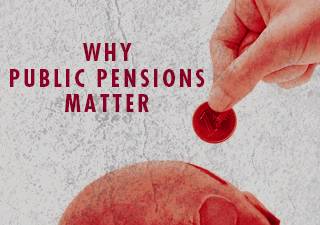Commentary

Will our Grandchildren be Budget Losers?
As the Governor’s state budget address approaches, there is no shortage of speculation surrounding various fiscal austerity proposals and which departments and programs will likely be the ultimate budgetary “winners and losers.”
State budgets come and go, but one group that is perennially relegated to “losers” is future generations of taxpayers who will choose to live, work or invest in Pennsylvania despite the overwhelming debt we will bequeath to them. But when the multi-billion dollar burden of underfunded pensions continues to be passed on to our grandchildren for the sake of political popularity, the truth is, we all lose.
In 2010, politicians passed a version of pension “reform” by deferring existing unfunded liabilities, making them even more unaffordable for future generations. The situation was so severe that they felt compelled to include a legislative provision that effectively capped contributions for several years despite repeated and significant concerns raised by independent actuaries that such a move would only further shortchange already underfunded plans.
So why haven’t legislators taken decisive actions to reduce pension liabilities? Quite simply, because addressing the ever-increasing pension deficits sooner rather than later carries a low political rate of return. Few in Harrisburg see any political upside, especially in an election year, to cutting their preferred programs in a “no tax increase” environment to address something as arcane as reducing an unfunded actuarial liability. This is short-term thinking at the expense of our children’s and state’s future.
Specifically, we are witnessing political angst given the Public School Employees’ Retirement System (PSERS) taxpayer contribution rate for FY 2012-13 will increase from 8.65 percent to 12.36 percent of payroll. This equates to a 43 percent increase – a jump of almost $295 million in the state budget and $242 million in school property taxes.
However, the sobering reality is PSERS actuaries have indicated that without the 2010 legislation this rate would have been 29.65 percent. That figure would be closer to 35 percent if one were to use a more appropriate (shorter) amortization period, the market value of assets, and future asset returns assumptions that are closer to 6 percent rather than 7.5 percent, which was used by PSERS (8 percent for SERS).
Hence, future contributions will continue to increase significantly even as the funding gaps grow.
This political subterfuge, a veritable shell game, is just manipulative policies for which our grandchildren will have to foot the bill. Any FY 2012-13 proposed state and local budget based upon this contribution rate is a financial mirage. With similar strategies occurring at SERS and in state retirees’ medical plans, total contributions for these three systems should be more than $3 billion above what is likely to be proposed with approximately $2 billion at the state level alone.
Within all this political maneuvering and demagoguery, an immovable and unanswered question remains: Why should current pension costs be legislatively assigned to our grandchildren? While any attempted answer may be politically expedient, it is absolutely immoral.
Therefore, the “future pension challenges” commonly heard in political rhetoric simply represent the unsustainable legacy of unpaid contributions, which will continue to mount with interest.
There is little political upside for policymakers to acknowledge such financial realities exist, especially since this should be accompanied by a discussion of how significant these existing deficits really are. For PSERS, SERS and state retiree medical plans, such deficits are at least (in billions) $20, $10, and $15 respectively. Add county and municipal pensions and other retiree benefit plans and it’s obvious why most politicians would rather focus on other issues.
And this all assumes earning a 7.5 and 8 percent return (for PSERS and SERS, respectively) on pension investments – anything less results in additional taxpayer costs. But a March 2011 Wilshire national investment study concluded that none of the 126 U.S. public pension plans studied are expected to earn more than 6.5 percent annually over the next 10 years.
Ultimately, the remedy should be to exit these defined benefit plans and increase near-term funding. If 2010 is a precursor of future reform, the next generation will be better off with a new direction using the private sector as a benchmark rather than euphemisms such as “partial reform.”
Pundits will continue to speculate over 2012 “winners and losers,” but if our children and grandchildren are forced to pay for our poor decisions today, then losers have been made of us all for generations to come.
# # #
Richard C. Dreyfuss is a Senior Fellow with the Commonwealth Foundation (www.commonwealthfoundation.org), Pennsylvania’s free-market think tank.